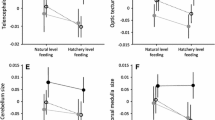Summary
Each alternative male reproductive morph in teleosts has a distinct suite of secondary sex characteristics including behavioural, endocrinological, somatic and brain traits. Accepting that the central nervous system (CNS) is the ‘seat’ of behaviour, then male dimorphisms in the CNS (whether e.g. morphological, chemical or biophysical) must determine the production of distinct male reproductive tactics. The available data suggest that the preoptic-pituitary/GnRH-gonadotropin axis provides a proximate mechanism that initiates testicular maturation, subsequent changes in titers of circulating sex steroids, and the expression of secondary sex characteristics. Individuals may be predisposed, developmentally, to express one male morph or the other. Thus, irrespective of the time during an individual male's postembryonic life that a GnRH cascade is initiated, he would express only one male morph. (Developmental predisposition may depend on genetic or epigenetic events.) Alternatively, the temporal relationship of a GnRH cascade to an individual's age or body size may be critical to determining which morph is expressed. Thus, if the GnRH ‘trigger’ were to occur at 1 year of age or 6 cm body size, a sneak-spawn tactic would be followed; at 2 years of age or 12 cm, a parental, nest-guarding tactic is followed. The latter mechanism is akin to that for sequential hermaphrodites, where an individual has the potential to express both reproductive tactics, although for species such as midshipman, only one morph is ever manifested. Irrespective of which developmental mechanism is operative, the result is a mating system with two male reproductive morphs, each of which has a distinct suite of traits subject to sexual and natural selection.
Similar content being viewed by others
References
Bass, A. (1992) Dimorphic male brains and alternative reproductive tactics in a vocalizing fish. Trends Neurosci. 15, 139–45.
Blumer, L.S. (1979) Male parental care in the bony fishes. Q. Rev. Biol. 54, 149–61.
Brantley, R.K. and Bass, A.H. (1991) Secondary sex characters in a vocalizing fish: intra- and intersexual dimorphism and role of androgens. Proc. Fourth Int. Symp. Reprod. Physiol. Fish, FishSymp, pp. 197–9.
Brantley, R.K., Tseng, J. and Bass, A.H. (1993a) The ontogeny of inter- and intrasexual vocal muscle dimorphisms in a sound-producing fish. Brain Behav. Evol. (in press).
Brantley, R.K., Marchaterre, M.A. and Bass, A.H. (1993b) Androgen effects on vocal muscle structure in a teleost fish with inter- and intrasexual dimorphism. J. Morph. (in press).
DeMartini, E.E. (1988) Spawning success of the male plainfin midshipman. I. Influences of male body size and area of spawning site. J. exp. mar. Biol. Ecol. 121, 177–92.
Grober, M.S. and Bass, A.H. (1991) Neuronal correlates of sex/role change in labrid fishes: LHRH-like immunoreactivity. Brain Behav. Evol. 38, 302–12.
Grober, M.S., Fox, S., Laughlin, C. and Bass, A.H. (1993) GnRH cell size and number in a teleost fish with two male reproductive morphs: sexual maturation, final sexual status and body size allometry. Brain Behav. Evol. (in press)
Gross, M.R. (1985) Disruptive selection for alternative life histories in salmon. Nature Lond. 313, 47–8.
Gross, M.R. (1991) Evolution of alternative reproductive strategies: frequency-dependent sexual selection in male bluegill sunfish. Phil. Trans. R. Soc. 332B, 59–66.
Halpern-Sebold, L., Schreibman, M.P. and Margolis-Nunno, H. (1986) Differences between early- and late-maturing genotypes of the platyfish (Xiphophorus maculatus) in the morphometry of their immunoreactive luteinizing hormone releasing hormone-containing cells: a developmental study. J. exp. Zool. 240, 245–57.
Hoar, W.S. (1988) The physiology of smolting salmonids. In Hoar, W.S. and Randall, D.J. eds. Fish Physiology, Vol. XIB. San Diego: Academic Press, pp. 275–344.
Livne, I., Gibson, M.J. and Silverman, A.-J. (1992a) Brain grafts of migratory GnRH cells induce gonadal recovery in hypogonadal (hpg) mice. Develop. Brain Res. 69, 117–23.
Livne, I., Silverman, A.-J. and Gibson, M.J. (1992b) Reversal of reproductive deficiency in the hpg male mouse by neonatal androgenization. Biol. Reprod. 47, 561–7.
Mason, A.J., Pitts, S.L., Nikolics, V., Szonyi, E., Wilcox, J.N., Seeburg, P.H. and Stewart, T.A. (1986) The hypogonadal mouse: reproductive functions restored by gene therapy. Science 234, 1372–8.
Morrell, J.I., Kelley, D.B. and Pfaff, D.W. (1975) Sex steroid binding in the brains of vertebrates. In Knigge, K.M. and Scott, D.E., eds Brain-Endocrine Interactions II. Basel: S. Karger AG, pp. 230–56.
Ryan, M.J. (1990) Signals, species and sexual selection. Am. Scient. 78, 46–52.
Sohn, J.J. and Crews, D. (1977) Size-mediated onset of genetically determined maturation in the platyfish, Xiphophorus maculatus. Proc natn Acad. Sci. (USA) 74, 4547–8.
Zimmerer, E.J. and Kallman, K.D. (1989) Genetic basis for the alternative reproductive tactics in the pygmy swordtail, Xiphophorus nigrensis. Evolution 43, 1298–307.
Author information
Authors and Affiliations
Rights and permissions
About this article
Cite this article
Bass, A.H. From brains to behaviour: hormonal cascades and alternative mating tactics in teleost fishes. Rev Fish Biol Fisheries 3, 181–186 (1993). https://doi.org/10.1007/BF00045231
Accepted:
Issue Date:
DOI: https://doi.org/10.1007/BF00045231




